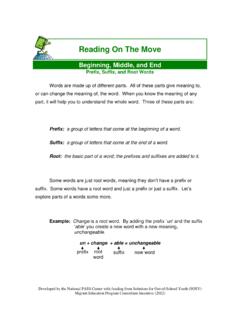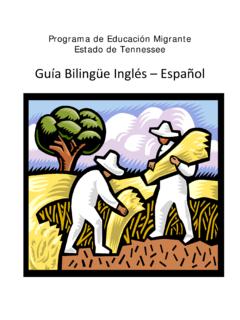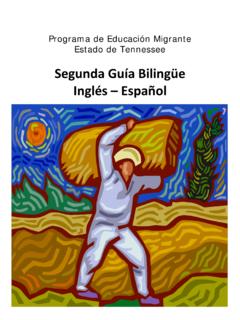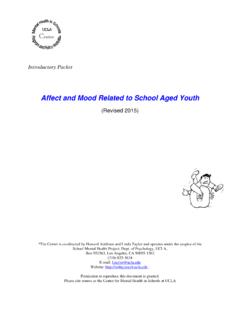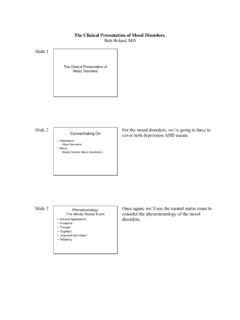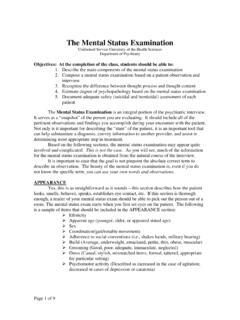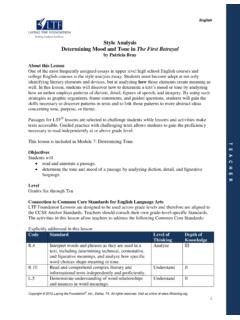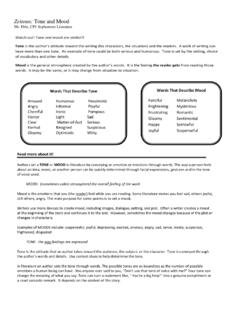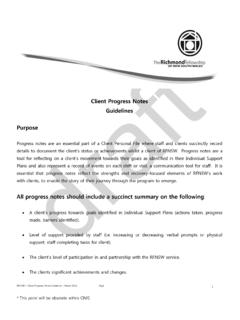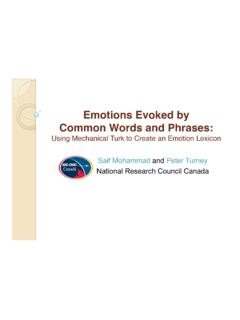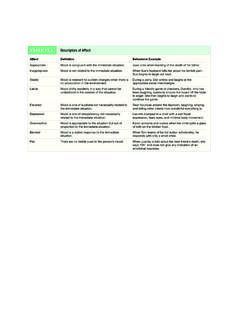Transcription of Reading On The Move - osymigrant.org
1 Developed by the National PASS Center with funding from Solutions for Out-of-School Youth (SOSY) Migrant Education Program Consortium Incentive (2012) Reading On The move Poetry: Form, Syllables, mood , and Tone A poem is a group of words that are written to express or draw out emotion, paint a picture, or give a sense of beauty. There are certain ways to identify poetry from prose. Prose is a group of words written in sentences and paragraphs, like you would read in a novel or essay. Poetry is written with breaks in the lines of text to create a certain sound. Poetry has a beat, or rhythm, and sometimes it rhymes.
2 It is often written in stanzas and uses imagery and figurative language to express emotions or ideas to the reader. This lesson will explore all of these poetry terms. There are some basics of poetry that are important to know. These basics give poetry organization and help it to flow. A stanza is when the lines of a poem are grouped together, as with a paragraph in prose. Stanzas may have any number of lines. It is important to note that a line in a stanza is not necessarily the number of sentences. Some lines are a complete sentence; some lines are only part of a sentence. The form of a poem is the way it looks on the page.
3 The form includes the number of lines in each stanza and the length of each line. Like a paragraph in prose, each stanza is separated by a blank space. Sometimes a stanza ends at the end of a complete idea, sometimes it ends in the middle of a sentence. Poets may do this to give the poem a certain flow. Reading On The move : Poetry: Form, Symbols, mood , and Tone Developed by the National PASS Center with funding from Solutions for Out-of-School Youth (SOSY) Migrant Education Program Consortium Incentive (2012) 2 Some poems are even written in the shape of the thing they are written about.
4 For example, if the poem is about an apple, the words in the poem are arranged in a way that creates the shape of an apple on the page. These poems are called concrete poems. The poem below is about arrows and the words create the shape of an arrow. Example: Poems that don t follow set patterns are written in free verse. Free verse is the trickiest type of poetry to tell apart from prose. Free verse is when poets write without any rules. He/she just write however he/she feels they can express themselves best. The example below is the concrete poem you just read written in free verse.
5 Example: Arrows Which way do I go? Up? Down? Left? Right? How do I find my way in this maze? Just follow the Reading On The move : Poetry: Form, Symbols, mood , and Tone Developed by the National PASS Center with funding from Solutions for Out-of-School Youth (SOSY) Migrant Education Program Consortium Incentive (2012) 3 The syllables in the poem play a major part in the meter. Meter is the rhythmic structure of verse, so in other words , the beat of the poem.
6 The meter relies on the placement and pattern of syllables in the verse. Syllables in a poem can be stressed ( \ ) or unstressed ( ). The stressed syllable is the long syllable and the unstressed syllable is the short syllable. Remember, words can have more than one syllable. Example: Roses are red, Violets are blue. Sugar is sweet, And so are you. You can see in this poem that the pattern of the syllables, or the meter, is the same for the first three lines and different for the last line. One type of poetry that is written based on syllables is Haiku. Haiku is a form of Japanese poetry in which an idea is expressed in just 17 syllables.
7 The format of these syllables is: line one is five syllables, line two is seven syllables, and line three is five syllables. Traditional Japanese haiku usually describes ideas that have to do with nature or the different seasons. As haiku has spread across the nations, the content of this poetry has broadened, but the format remains the same: 5-7-5. \ \ \ \ \ \ \ \ Reading On The move : Poetry: Form, Symbols, mood , and Tone Developed by the National PASS Center with funding from Solutions for Out-of-School Youth (SOSY) Migrant Education Program Consortium Incentive (2012) 4 Example: 1 Prickly cactus, 2 Bright green in the desert sun.
8 3 A vulture swoops by. Pric- kle- -y cac- tus, Bright green in the des- -ert sun. A vul- -ture swoops by. Line 1: 5 syllables Line 2: 7 syllables Line 3: 5 syllables Reading On The move : Poetry: Form, Symbols, mood , and Tone Developed by the National PASS Center with funding from Solutions for Out-of-School Youth (SOSY) Migrant Education Program Consortium Incentive (2012) 51. Try writing your own haiku in the space below. Remember: It must be three lines long. Line one has five syllables. Line two has seven syllables. Line three has five syllables.
9 It should be about nature. Reading On The move : Poetry: Form, Symbols, mood , and Tone Developed by the National PASS Center with funding from Solutions for Out-of-School Youth (SOSY) Migrant Education Program Consortium Incentive (2012) 6 mood is the feeling created by the poet for the reader. Tone is the feeling displayed by the author toward the subject of the poem. mood and tone often depend on one another to get across what the author is trying to portray. Example: Some words that can describe the mood of a poem might be: romantic, realistic, optimistic, pessimistic, gloomy, mournful, sorrowful, etc.
10 Some words that can describe the tone of a poem might be: serious, humorous, amused, angry, playful, cheerful, sad, gloomy, etc. Example: Deadly Winter Barren branches pierce the sky, Chattering in the shivering breeze. The clouds hold captive Rays of the gloomy sunshine. Blades of grass brown and tattered From frost s sharp fingernails. Winter squeezes the last breath Out of all that once thrived. This poem s mood could be described as gloomy because the poem is about death. The tone might be described as serious. The words used in the poem give clues as to how the author feels about winter.

